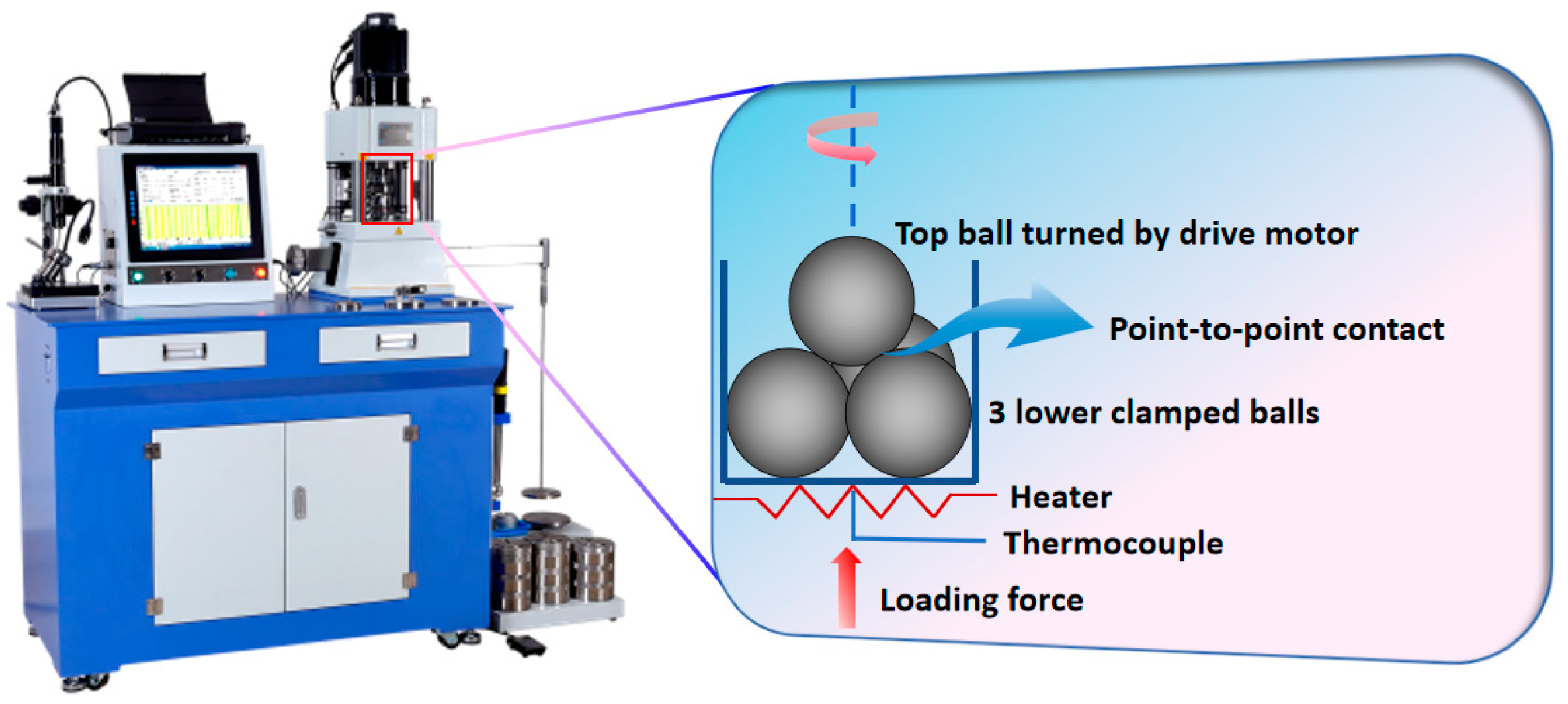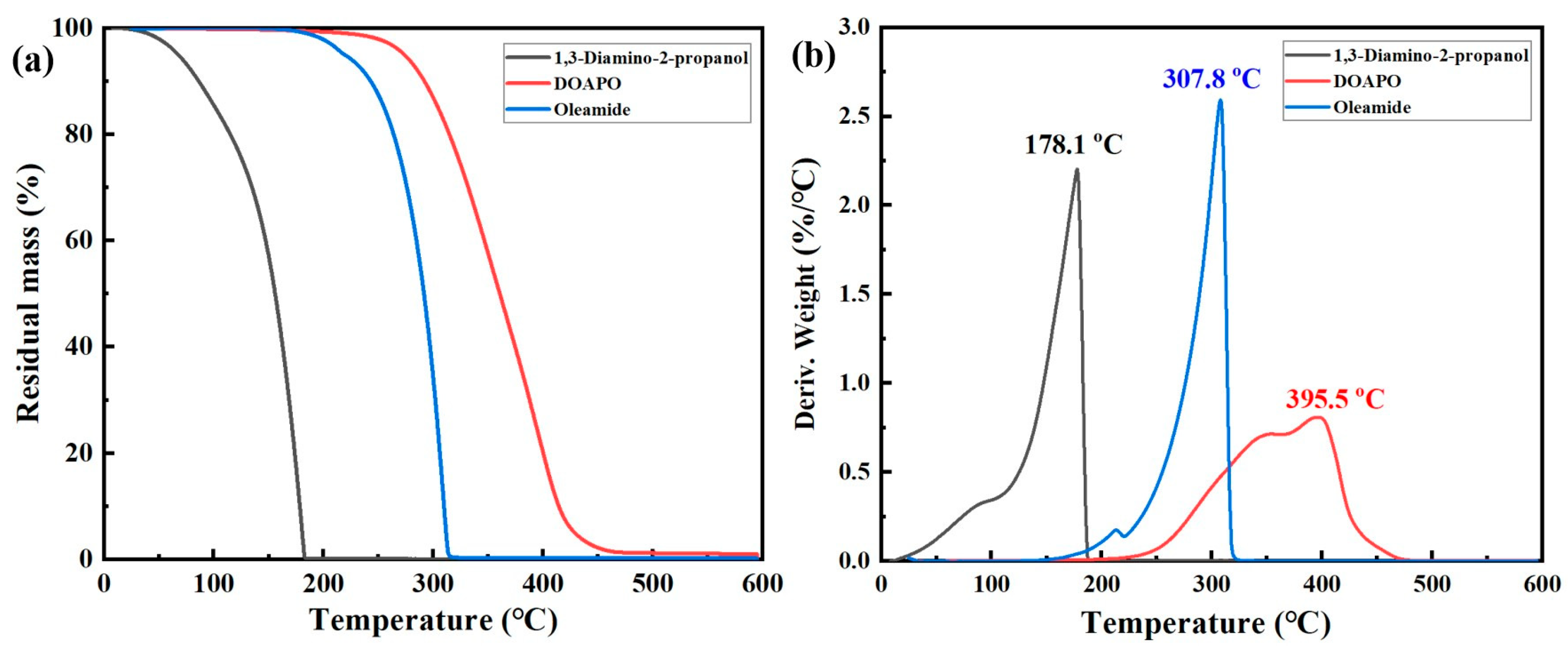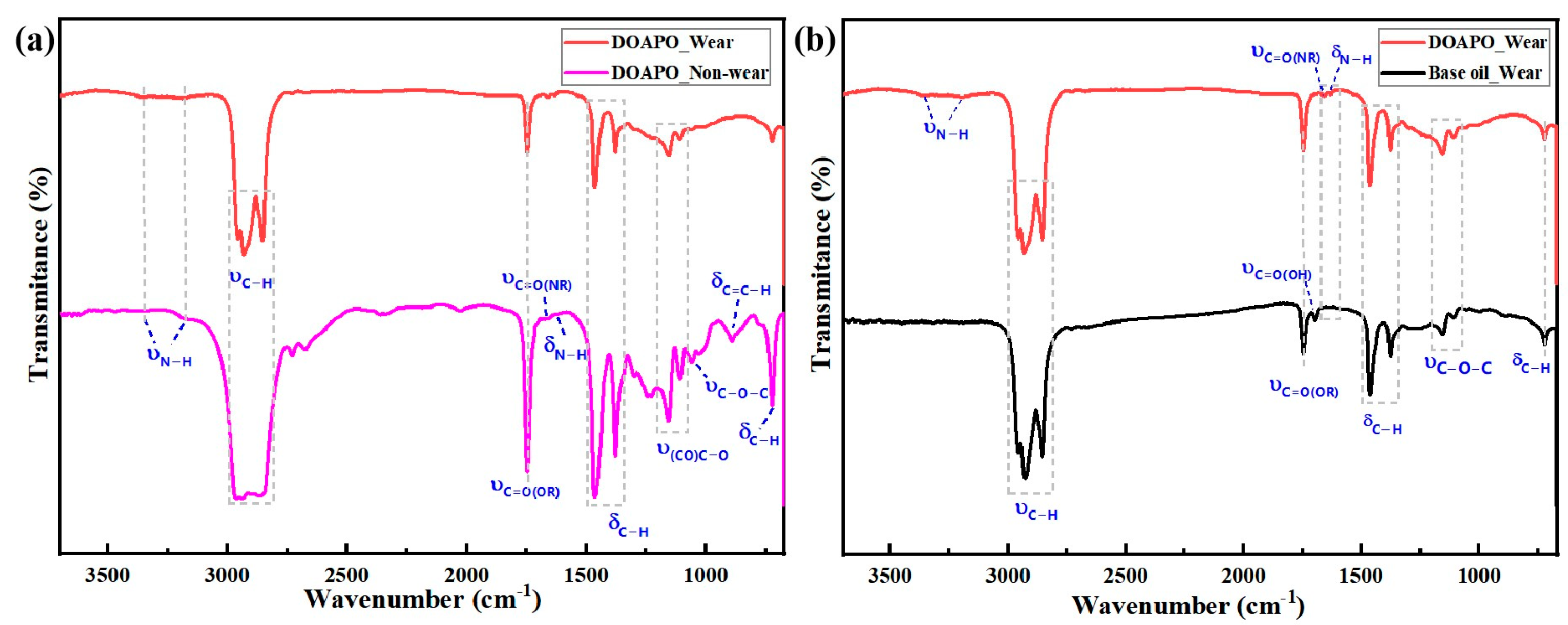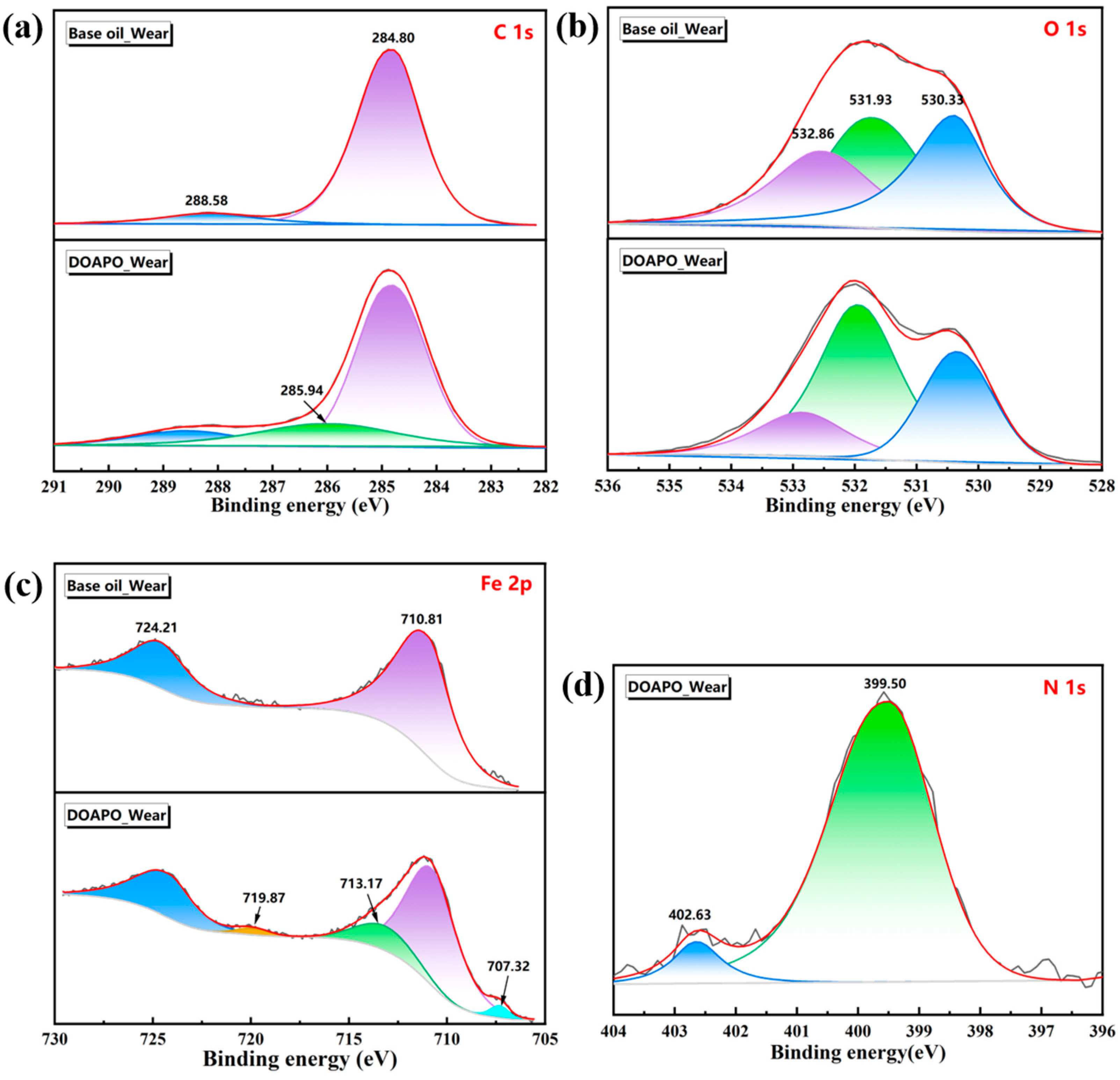Preparation and Tribological Behaviors of Sulfur- and Phosphorus-Free Organic Friction Modifier of Amide–Ester Type
Abstract
1. Introduction
2. Materials and Methods
2.1. Materials
2.2. Synthesis of 1,3-Dioleoamide-2-Propyloleate (DOAPO)
2.3. Characterization
2.4. Oil Preparation
2.5. Tribological Test
3. Results and Discussion
3.1. Synthesis Route of DOAPO
3.2. Thermal Stability of DOAPO
3.3. Storage Stability of DOAPO in Synthetic Base Oil
3.4. Tribological Properties of DOAPO
3.4.1. Different Additions of DOAPO
3.4.2. Comparison with the Commercial Oleamide
3.5. Micro-Lubrication Mechanism
3.5.1. Worn Surface Analysis
3.5.2. DFT Calculation
4. Conclusions
- (1)
- The introduction and multi-structure of long alkyl chains make DOAPO exhibit better storage stability in synthetic base oil and better thermal stability than that of commercial oleamide, whose residual mass at 300 °C is 86.9% vs. 33.9%.
- (2)
- The optimal addition of DOAPO in the selected synthetic base oil is 0.5 wt.%, which can not only effectively shorten the running-in period compared to base oil (120 s vs. 600 s) but also reduce ave. COF and ave. WSD by 8.2% and 16.2%, respectively, which is better than that of commercial oleamide.
- (3)
- The worn surface analysis and DFT calculation show that although the adsorption of DOAPO on metal surfaces is slightly weaker than oleamide (ESP: −0.0656 vs. 0.0689), its ester bond breaks preferentially during friction, which could reduce the interfacial shear force and easily react with metal surfaces to form iron oxide films, thus demonstrating better friction-reducing and anti-wear performance.
Supplementary Materials
Author Contributions
Funding
Data Availability Statement
Conflicts of Interest
References
- Wong, V.W.; Tung, S.C. Overview of Automotive Engine Friction and Reduction Trends–Effects of Surface, Material, and Lubricant-Additive Technologies. Friction 2016, 4, 1–28. [Google Scholar] [CrossRef]
- McQueen, J.S.; Gao, H.; Black, E.D.; Gangopadhyay, A.K.; Jensen, R.K. Friction and Wear of Tribofilms Formed by Zinc Dialkyl Dithiophosphate Antiwear Additive in Low Viscosity Engine Oils. Tribol. Int. 2005, 38, 289–297. [Google Scholar] [CrossRef]
- Spikes, H. Friction Modifier Additives. Tribol. Lett. 2015, 60, 5. [Google Scholar] [CrossRef]
- Vaitkunaite, G.; Espejo, C.; Wang, C.; Thiébaut, B.; Charrin, C.; Neville, A.; Morina, A. MoS2 Tribofilm Distribution from Low Viscosity Lubricants and Its Effect on Friction. Tribol. Int. 2020, 151, 106531. [Google Scholar] [CrossRef]
- Hou, J.; Tsukamoto, M.; Hor, S.; Chen, X.; Yang, J.; Zhang, H.; Koga, N.; Yasuda, K.; Fukuzawa, K.; Itoh, S.; et al. Molecules with a TEMPO-Based Head Group as High-Performance Organic Friction Modifiers. Friction 2023, 11, 316–332. [Google Scholar] [CrossRef]
- Zhou, Y.; Qu, J. Ionic Liquids as Lubricant Additives: A Review. ACS Appl. Mater. Interfaces 2017, 9, 3209–3222. [Google Scholar] [CrossRef] [PubMed]
- Tang, Z.; Li, S. A Review of Recent Developments of Friction Modifiers for Liquid Lubricants (2007–Present). Curr. Opin. Solid State Mater. Sci. 2014, 18, 119–139. [Google Scholar] [CrossRef]
- Meng, Y.; Xu, J.; Jin, Z.; Prakash, B.; Hu, Y. A Review of Recent Advances in Tribology. Friction 2020, 8, 221–300. [Google Scholar] [CrossRef]
- Peeters, S.; Restuccia, P.; Loehlé, S.; Thiebaut, B.; Righi, M.C. Tribochemical Reactions of MoDTC Lubricant Additives with Iron by Quantum Mechanics/Molecular Mechanics Simulations. J. Phys. Chem. C 2020, 124, 13688–13694. [Google Scholar] [CrossRef]
- Sarin, R.; Tuli, D.K.; Sureshbabu, A.V.; Misra, A.K.; Rai, M.M.; Bhatnagar, A.K. Molybdenum Dialkylphosphorodithioates: Synthesis and Performance Evaluation as Multifunctional Additives for Lubricants. Tribol. Int. 1994, 27, 379–386. [Google Scholar] [CrossRef]
- Casford, M.T.L.; Puhan, D.; Davies, P.B.; Bracchi, G.L.; Smith, T.D. Thermal Behaviour of Synovene and Oleamide in Oil Adsorbed on Steel. Tribol. Lett. 2020, 68, 52. [Google Scholar] [CrossRef]
- Shu, J.; Harris, K.; Munavirov, B.; Westbroek, R.; Leckner, J.; Glavatskih, S. Tribology of Polypropylene and Li-Complex Greases with ZDDP and MoDTC Additives. Tribol. Int. 2018, 118, 189–195. [Google Scholar] [CrossRef]
- Tsagkaropoulou, G.; Warrens, C.P.; Camp, P.J. Interactions between Friction Modifiers and Dispersants in Lubricants: The Case of Glycerol Monooleate and Polyisobutylsuccinimide-Polyamine. ACS Appl. Mater. Interfaces 2019, 11, 28359–28369. [Google Scholar] [CrossRef] [PubMed]
- Zhang, Z.; Yamaguchi, E.S.; Kasrai, M.; Bancroft, G.M.; Liu, X.; Fleet, M.E. Tribofilms Generated from ZDDP and DDP on Steel Surfaces: Part 2, Chemistry. Tribol. Lett. 2005, 19, 221–229. [Google Scholar] [CrossRef]
- Zhang, Z.; Yamaguchi, E.S.; Kasrai, M.; Bancroft, G.M. Tribofilms Generated from ZDDP and DDP on Steel Surfaces: Part 1, Growth, Wear and Morphology. Tribol. Lett. 2005, 19, 211–220. [Google Scholar] [CrossRef]
- Li, W.; Kumara, C.; Meyer, H.M.; Luo, H.; Qu, J. Compatibility between Various Ionic Liquids and an Organic Friction Modifier as Lubricant Additives. Langmuir 2018, 34, 10711–10720. [Google Scholar] [CrossRef] [PubMed]
- Ewen, J.P.; Gattinoni, C.; Morgan, N.; Spikes, H.A.; Dini, D. Nonequilibrium Molecular Dynamics Simulations of Organic Friction Modifiers Adsorbed on Iron Oxide Surfaces. Langmuir 2016, 32, 4450–4463. [Google Scholar] [CrossRef]
- Lundgren, S.M.; Persson, K.; Mueller, G.; Kronberg, B.; Clarke, J.; Chtaib, M.; Claesson, P.M. Unsaturated Fatty Acids in Alkane Solution: Adsorption to Steel Surfaces. Langmuir 2007, 23, 10598–10602. [Google Scholar] [CrossRef] [PubMed]
- Ratoi, M.; Niste, V.B.; Alghawel, H.; Suen, Y.F.; Nelson, K. The Impact of Organic Friction Modifiers on Engine Oil Tribofilms. RSC Adv. 2014, 4, 4278–4285. [Google Scholar] [CrossRef]
- Khatri, P.K.; Sadanandan, A.M.; Thakre, G.D.; Jain, S.L.; Singh, R.; Gupta, P. Tribo-Performance of the Ionic Liquids Derived from Dicarboxylic Acids as Lubricant Additives for Reducing Wear and Friction. J. Mol. Liq. 2022, 364, 119941. [Google Scholar] [CrossRef]
- Campen, S.; Green, J.H.; Lamb, G.D.; Spikes, H.A. In Situ Study of Model Organic Friction Modifiers Using Liquid Cell AFM; Saturated and Mono-Unsaturated Carboxylic Acids. Tribol. Lett. 2015, 57, 18. [Google Scholar] [CrossRef]
- Cyriac, F.; Yamashita, N.; Hirayama, T.; Yi, T.X.; Poornachary, S.K.; Chow, P.S. Mechanistic Insights into the Effect of Structural Factors on Film Formation and Tribological Performance of Organic Friction Modifiers. Tribol. Int. 2021, 164, 107243. [Google Scholar] [CrossRef]
- Zhang, T.; Liu, S.; Zhang, X.; Gao, J.; Yu, H.; Ye, Q.; Liu, S.; Liu, W. Fabrication of Two-Dimensional Functional Covalent Organic Frameworks via the Thiol-Ene “Click” Reaction as Lubricant Additives for Antiwear and Friction Reduction. ACS Appl. Mater. Interfaces 2021, 13, 36213–36220. [Google Scholar] [CrossRef] [PubMed]
- Kuwahara, T.; Romero, P.A.; Makowski, S.; Weihnacht, V.; Moras, G.; Moseler, M. Mechano-Chemical Decomposition of Organic Friction Modifiers with Multiple Reactive Centres Induces Superlubricity of Ta-C. Nat. Commun. 2019, 10, 151. [Google Scholar] [CrossRef] [PubMed]
- Fry, B.M.; Chui, M.Y.; Moody, G.; Wong, J.S.S. Interactions between Organic Friction Modifier Additives. Tribol. Int. 2020, 151, 106438. [Google Scholar] [CrossRef]
- Hu, W.; Xu, Y.; Zeng, X.; Li, J. Alkyl-Ethylene Amines as Effective Organic Friction Modifiers for the Boundary Lubrication Regime. Langmuir 2020, 36, 6716–6727. [Google Scholar] [CrossRef] [PubMed]
- Fry, B.M.; Moody, G.; Spikes, H.A.; Wong, J.S.S. Adsorption of Organic Friction Modifier Additives. Langmuir 2020, 36, 1147–1155. [Google Scholar] [CrossRef] [PubMed]
- Faujdar, E.; Singh, R.K. Amide Polymers Based on N-phenyl-p-phenylenediamine with α-olefins-co-maleic Anhydride as Multifunctional Additives for Lubricant Application. Polym. Adv. Techs 2022, 33, 2820–2834. [Google Scholar] [CrossRef]
- Lee, J.; Kim, B.; Lee, J.W.; Hong, C.Y.; Kim, G.H.; Lee, S.J. Bioinspired Fatty Acid Amide-Based Slippery Oleogels for Shear-Stable Lubrication. Adv. Sci. 2022, 9, 2105528. [Google Scholar] [CrossRef]
- Faujdar, E.; Negi, H.; Bhonsle, A.; Atray, N.; Singh, R.K. Efficiency of Dodecenylsuccinic Amide of n-Phenyl-p-Phenylenediammine as Novel Multifunctional Lubricant Additive for Deposit Control and Lubricity. J. Surfactants Deterg. 2021, 24, 173–184. [Google Scholar] [CrossRef]
- Biresaw, G.; Compton, D.; Evans, K.; Bantchev, G.B. Lipoate Ester Multifunctional Lubricant Additives. Ind. Eng. Chem. Res. 2016, 55, 373–383. [Google Scholar] [CrossRef]
- Tanaka, H.; Nagashima, T.; Sato, T.; Kawauchi, S. The Effect of 0W-20 Low Viscosity Engine Oil on Fuel Economy; No. 1999-01–3468; SAE International: Warrendale, PA, USA, 1999. [Google Scholar] [CrossRef]
- NB/SH/T 0189-2017; Standard Test Method for Wear Preventive Characteristics of Lubricating Fluid—Four-Ball Method. National Energy Board: Beijing, China, 2017.
- Wang, Y.; Lu, Q.; Xie, H.; Liu, S.; Ye, Q.; Zhou, F.; Liu, W. In-Situ Formation of Nitrogen Doped Microporous Carbon Nanospheres Derived from Polystyrene as Lubricant Additives for Anti-Wear and Friction Reduction. Friction 2023, 12, 439–451. [Google Scholar] [CrossRef]
- De Barros, M.I.; Bouchet, J.; Raoult, I.; Le Mogne, T.; Martin, J.M.; Kasrai, M.; Yamada, Y. Friction Reduction by Metal Sulfides in Boundary Lubrication Studied by XPS and XANES Analyses. Wear 2003, 254, 863–870. [Google Scholar]
- Fan, X.; Wang, L. High-Performance Lubricant Additives Based on Modified Graphene Oxide by Ionic Liquids. J. Colloid Interface Sci. 2015, 452, 98–108. [Google Scholar] [CrossRef] [PubMed]
- Zhang, R.; Liu, X.; Guo, Z.; Cai, M.; Shi, L. Effective Sugar-Derived Organic Gelator for Three Different Types of Lubricant Oils to Improve Tribological Performance. Friction 2020, 8, 1025–1038. [Google Scholar] [CrossRef]
- Huang, J.; Li, Y.; Jia, X.; Song, H. Preparation and Tribological Properties of Core-Shell Fe3O4@C Microspheres. Tribol. Int. 2019, 129, 427–435. [Google Scholar] [CrossRef]
- Hu, J.; Zhang, Y.; Yang, G.; Gao, C.; Song, N.; Zhang, S.; Zhang, P. In-Situ Formed Carbon Based Composite Tribo-Film with Ultra-High Load Bearing Capacity. Tribol. Int. 2020, 152, 106577. [Google Scholar] [CrossRef]
- Lee, A.Y.; Blakeslee, D.M.; Powell, C.J.; John, R.; Rumble, J. Development of the Web-Based NIST X-ray Photoelectron Spectroscopy (XPS) Database. Data Sci. J. 2006, 1, 1. [Google Scholar] [CrossRef]
- Otero, I.; López, E.R.; Reichelt, M.; Fernández, J. Tribo-Chemical Reactions of Anion in Pyrrolidinium Salts for Steel–Steel Contact. Tribol. Int. 2014, 77, 160–170. [Google Scholar] [CrossRef]
- Lu, Q.; Wang, H.; Ye, C.; Liu, W.; Xue, Q. Room Temperature Ionic Liquid 1-Ethyl-3-Hexylimidazolium-Bis(Trifluoromethylsulfonyl)-Imide as Lubricant for Steel–Steel Contact. Tribol. Int. 2004, 37, 547–552. [Google Scholar] [CrossRef]










Disclaimer/Publisher’s Note: The statements, opinions and data contained in all publications are solely those of the individual author(s) and contributor(s) and not of MDPI and/or the editor(s). MDPI and/or the editor(s) disclaim responsibility for any injury to people or property resulting from any ideas, methods, instructions or products referred to in the content. |
© 2024 by the authors. Licensee MDPI, Basel, Switzerland. This article is an open access article distributed under the terms and conditions of the Creative Commons Attribution (CC BY) license (https://creativecommons.org/licenses/by/4.0/).
Share and Cite
Xu, X.; Yang, F.; Yang, H.; Zhao, Y.; Sun, X.; Tang, Y. Preparation and Tribological Behaviors of Sulfur- and Phosphorus-Free Organic Friction Modifier of Amide–Ester Type. Lubricants 2024, 12, 196. https://doi.org/10.3390/lubricants12060196
Xu X, Yang F, Yang H, Zhao Y, Sun X, Tang Y. Preparation and Tribological Behaviors of Sulfur- and Phosphorus-Free Organic Friction Modifier of Amide–Ester Type. Lubricants. 2024; 12(6):196. https://doi.org/10.3390/lubricants12060196
Chicago/Turabian StyleXu, Xiaomei, Fan Yang, Hongmei Yang, Yanan Zhao, Xiuli Sun, and Yong Tang. 2024. "Preparation and Tribological Behaviors of Sulfur- and Phosphorus-Free Organic Friction Modifier of Amide–Ester Type" Lubricants 12, no. 6: 196. https://doi.org/10.3390/lubricants12060196
APA StyleXu, X., Yang, F., Yang, H., Zhao, Y., Sun, X., & Tang, Y. (2024). Preparation and Tribological Behaviors of Sulfur- and Phosphorus-Free Organic Friction Modifier of Amide–Ester Type. Lubricants, 12(6), 196. https://doi.org/10.3390/lubricants12060196






